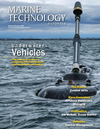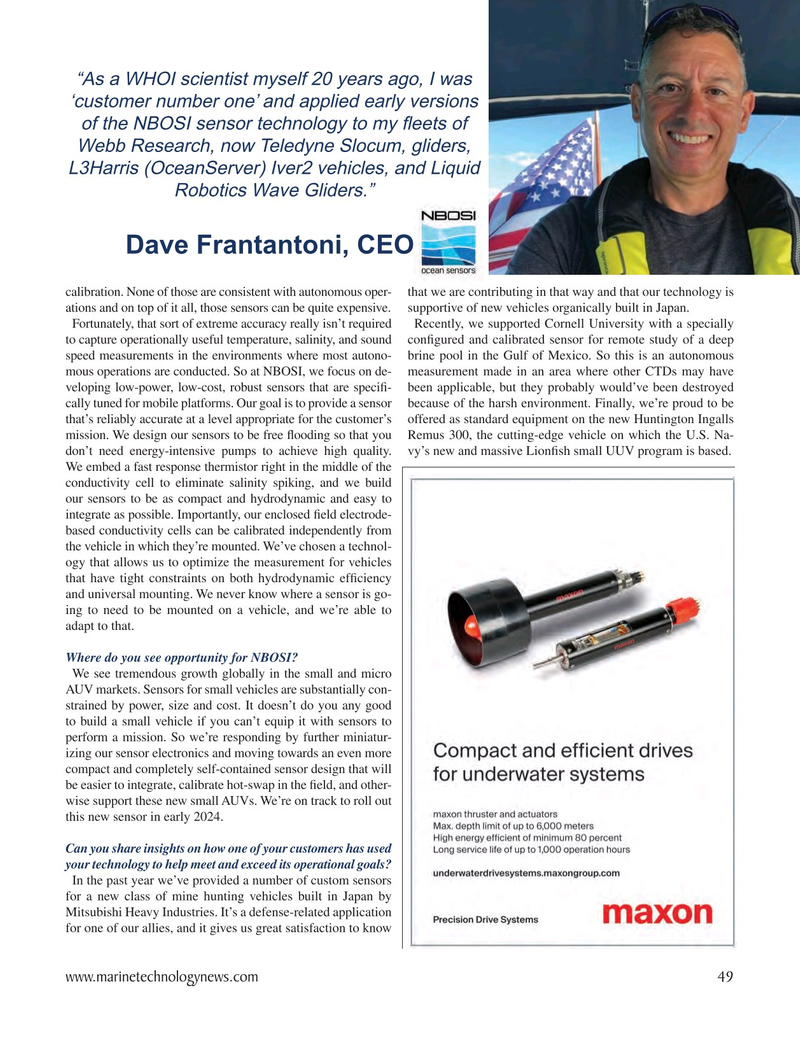
Page 49: of Marine Technology Magazine (January 2024)
Read this page in Pdf, Flash or Html5 edition of January 2024 Marine Technology Magazine
“As a WHOI scientist myself 20 years ago, I was ‘customer number one’ and applied early versions of the NBOSI sensor technology to my ? eets of
Webb Research, now Teledyne Slocum, gliders,
L3Harris (OceanServer) Iver2 vehicles, and Liquid
Robotics Wave Gliders.”
Dave Frantantoni, CEO calibration. None of those are consistent with autonomous oper- that we are contributing in that way and that our technology is ations and on top of it all, those sensors can be quite expensive. supportive of new vehicles organically built in Japan.
Fortunately, that sort of extreme accuracy really isn’t required Recently, we supported Cornell University with a specially to capture operationally useful temperature, salinity, and sound con? gured and calibrated sensor for remote study of a deep speed measurements in the environments where most autono- brine pool in the Gulf of Mexico. So this is an autonomous mous operations are conducted. So at NBOSI, we focus on de- measurement made in an area where other CTDs may have veloping low-power, low-cost, robust sensors that are speci? - been applicable, but they probably would’ve been destroyed cally tuned for mobile platforms. Our goal is to provide a sensor because of the harsh environment. Finally, we’re proud to be that’s reliably accurate at a level appropriate for the customer’s offered as standard equipment on the new Huntington Ingalls mission. We design our sensors to be free ? ooding so that you Remus 300, the cutting-edge vehicle on which the U.S. Na- don’t need energy-intensive pumps to achieve high quality. vy’s new and massive Lion? sh small UUV program is based.
We embed a fast response thermistor right in the middle of the conductivity cell to eliminate salinity spiking, and we build our sensors to be as compact and hydrodynamic and easy to integrate as possible. Importantly, our enclosed ? eld electrode- based conductivity cells can be calibrated independently from the vehicle in which they’re mounted. We’ve chosen a technol- ogy that allows us to optimize the measurement for vehicles that have tight constraints on both hydrodynamic ef? ciency and universal mounting. We never know where a sensor is go- ing to need to be mounted on a vehicle, and we’re able to adapt to that.
Where do you see opportunity for NBOSI?
We see tremendous growth globally in the small and micro
AUV markets. Sensors for small vehicles are substantially con- strained by power, size and cost. It doesn’t do you any good to build a small vehicle if you can’t equip it with sensors to perform a mission. So we’re responding by further miniatur- izing our sensor electronics and moving towards an even more compact and completely self-contained sensor design that will be easier to integrate, calibrate hot-swap in the ? eld, and other- wise support these new small AUVs. We’re on track to roll out this new sensor in early 2024.
Can you share insights on how one of your customers has used your technology to help meet and exceed its operational goals?
In the past year we’ve provided a number of custom sensors for a new class of mine hunting vehicles built in Japan by
Mitsubishi Heavy Industries. It’s a defense-related application for one of our allies, and it gives us great satisfaction to know www.marinetechnologynews.com 49
MTR #1 (34-49).indd 49 1/31/2024 3:37:05 PM

 48
48

 50
50
